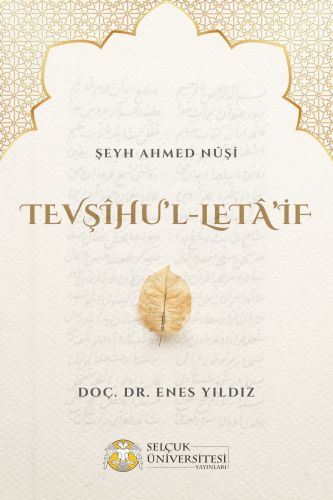
Tevşîhu'l-Letâ'if
Synopsis
Tevşîhu’l-Letâ’if
This work in your hand constitutes an important link in the tradition of verse advice in classical Turkish literature. This masnavi named Tevşîhu’l-Letâ’if was written in the 17th century. It was written by Şeyh Ahmed Nûşî. Information about Nûşî’s life is limited in the sources. Ahmed Nûşî Efendi, about whose birth and death we do not have definitive information, is the son of Tireli Ayşî Efendi. We have Tevşîhu’l-Letâ’if, Mir’âtü’z-Zamân, El-Kasîdetü’n-Nûşiyye and some of his poems from the works of Nûşî, who took lessons from Abdülaziz Efendi. The idea of working on this important advice called Tevşîhu’l-Letâ’if arose during our research in Medina Arif Hikmet Library. As a result of the literature review we witnessed that no scientific study has been done on Nûşî and Tevşîhu’l-Letâ’if. We began to work on masnavi, with the conviction that this important verse advice, which has been neglected and has not come to light until today, needs to be researched in every aspect, and at the end of our work, this work emerged. This book about Tevşîhu’l-Letâ’if consists of three parts: In the first part of the study Ahmed Nûşî's life, literary personality and works are introduced. Very little information has been found about the poet or his masnavi in other biographical sources. For this reason, most of the information and evaluations about Ahmed Nûşî’s life and literary personality have been put forward based on Tevşîhu’l-Letâ’if. In the second part, the masnavi in question was examined in terms of form, content, language and stylistic features. Under the title of "Formal Features of Tevşîhu’l-Letâ’if", “verse form, name of the masnavi, pseudonym of the poet, date of writing of the work, chapters and headings, number of couplets, rhyme, rhyme and meter” were emphasized and the shape of the masnavi was given by giving witness couplets. The content features of Tevşîhu’l-Letâ’if were examined one by one according to the order of subjects in the work. While conveying his advice to the reader in this work, Nûşî followed an important and effective path, as he stated in the introduction section. The poet says in the preface section of his masnavi: “... Tevşîhu’l-Letâ’if became famous by making one article and two stories.” As can be seen, Nûşî first deals with a subject in his masnavi and then tells two stories about the subject. By giving a quote from the story, that is, by giving two representations appropriate to the relevant topic, the readers have been enabled to understand the advice more easily. In addition, after the articles and stories, Nûşî addresses himself with a few couplets and gives advice to himself regarding the subject covered in the chapter and lists his prayers. In the main part of Tevşîhu’l-Letâ’if, the following topics are discussed: “True love, pride, knowledge and ignorance, justice, the mortality of the world, being awake at dawn, sincerity, patience, perseverance and sacrifice in the way of Muhammad, supplication and prayer to Allah.”
At the end of this section, it is possible to find the linguistic and stylistic features of the masnavi. In the third part of the study, the text of Tevşîhu’l-Letâ’if is revealed. The text is based on the three copies of Tevşîhu’l-Letâ’if that we have access to. One of these copies is registered in Medina Arif Hikmet Library, Turkish Manuscripts Department, archive number 26/811, the second is registered in Istanbul University Library, Turkish Manuscripts Department, NEKTY 01868 archive number, and the third is registered in Süleymaniye Library, Halet Efendi, archive number 00118. We would like to point out that we encountered some problems while presenting the critical text. For this reason, it is certain and natural that there will be mistakes and deficiencies caused by the work or by us. We would like to state that the criticism on deficiencies and flaws and the different reading suggestions and warnings offered in the text will contribute to our work and to us. Our wish is that the most complete text will emerge with the discovery of a new copy or copies of Tevşîhu’l-Letâ’if.
Chapters
-
Chapter INûşî's Life, Literary Personality and Works
-
Chapter IITevşîhu'l-Letâ'if
-
Chapter IIIText

